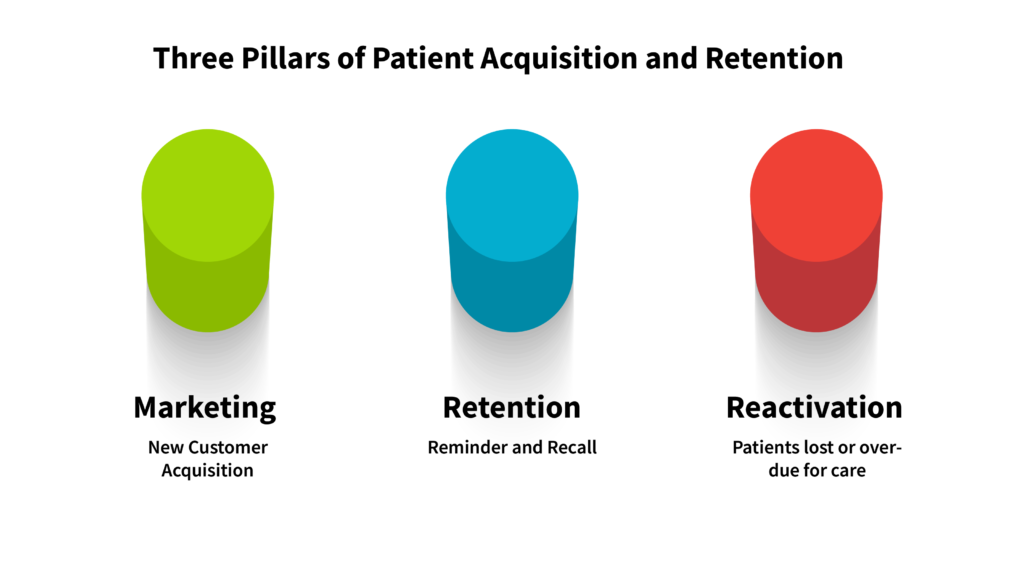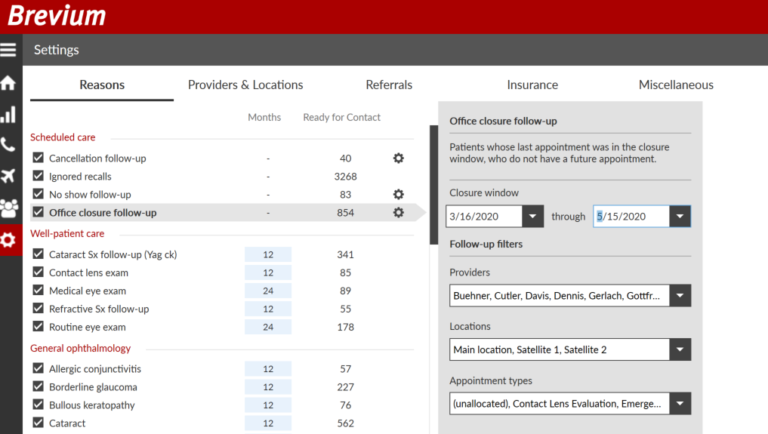The Brevium Blog

Discover the Third Pillar of Patient Acquisition and Retention
Your patient acquisition and retention strategy should comprise three pillars, yet most practices currently employ only two. The three pillars are marketing, patient retention, and patient reactivation.
Marketing is how you reach new patients through advertising, social media, online reputation management, community outreach, and similar activities. This is also called new-patient acquisition.
Retention is even more important, because this is how to keep current patients coming back, which is five to 25 times easier and less expensive than acquiring new patients. Patient retention includes recalls and reminders to ensure current patients keep their appointments and don’t fall out of your current-customer database, as well as other retention efforts such as maintaining a friendly office, having expert providers, and running efficient back-office practices.
Reactivation, is the forgotten pillar, because most practices have given up on the patients in this segment. Inactive patients are people who used to be active but haven’t responded to your recalls and appointment reminders for several months, and your practice has written them off. Yet their contact information is still in your database, and you have an established relationship with them. These patients are also still in that group that is five to 25 times easier to reach and reactivate than acquiring new patients. Your database probably holds 1,000 to 2,000 of these patients for each of your providers. We have found that with two cost-effective and easy-to-implement strategies, you can reactivate some 25 percent of these patients, even if they have been inactive for eight months to five years. That’s 250 to 500 patients you don’t need to spend a lot of money or time to turn into active patients.
Mine Your Database
Your first step to reactivating inactive patients is to take a deep look into your database to determine which patients you want to bring back. If you’ve switched practice management systems in the past few years, be sure also to stitch your old database. Begin by inventorying your practice needs. For example, do you have seasoned providers who specialize in high-risk patients, or does your practice have new offices or new providers that need to fill their schedules quickly? Search through your database to identify those inactive patients who match your needs. List patients who require high-value care, who live in the region of your new practice, or who may need lower-value care but could fill the calendars of new providers. We are experts in this area and provide patient management software that mines your database. Once you’ve identified the inactive patients you want to target, begin reactivating them using best practices.
Employ Best Practices
We conducted a study [1] that looked at patient reactivation, patient behavior patterns, and the value of various contact methods. We discovered that even when practices had given up on patients after exhausting their recall efforts, these patients would still respond with the right type and frequency of contact. Live phone calls, automated phone calls, mail such as postcards, text, and email, were very effective, in that priority order. The other key was repeating contact attempts beyond the point when reasonable practices would have given up. These patients responded in increasing numbers with each contact up to nine. Even beyond nine, some patients required even more contacts before they responded. We provide a service that applies these learnings to reactivate patients.
We recommend that you employ all three pillars to fill your patient calendars. Continue to dedicate significant resources to marketing to new patients. Continue current-patient retention using recall and appointment reminder tools, as well as other retention efforts. Be sure to establish a new focus on patient reactivation to realize significant results. Don’t confuse reactivation with patient recalls and reminders, because although the contact methods are similar, reactivation requires rethinking your tools and creating a new contact strategy. You need to make a plan to mine your patient database for the inactive patients whom you want to reactivate, and you need to develop a new plan to contact these lost patients the right number of times using the most effective methods.
The ALOHA study says you’re missing out on up to 27% of patients that could be re-activated! This can cause patients to end up with costly untreated issues and you lose out on revenue. By employing re-activation efforts, 81% of those patients can be re-activated with several attempts of contact by a practice.
Brevium is the pioneer in patient reactivation. Brevium’s software mines its clients’ patient databases using customized algorithms to improve the patient appointment lifecycle™. Hundreds of practices have found Brevium to be a trusted partner, with personalized training and unlimited support. Through original research and software development, Brevium helps ensure that patients return for the care they need, and practices derive the greatest financial benefit from the patient appointment lifecycle™.

References
| ↑1 | Analysis of Lost, Overdue, High-Risk, Absentee Patients (ALOHA) study, 2020. |
|---|














